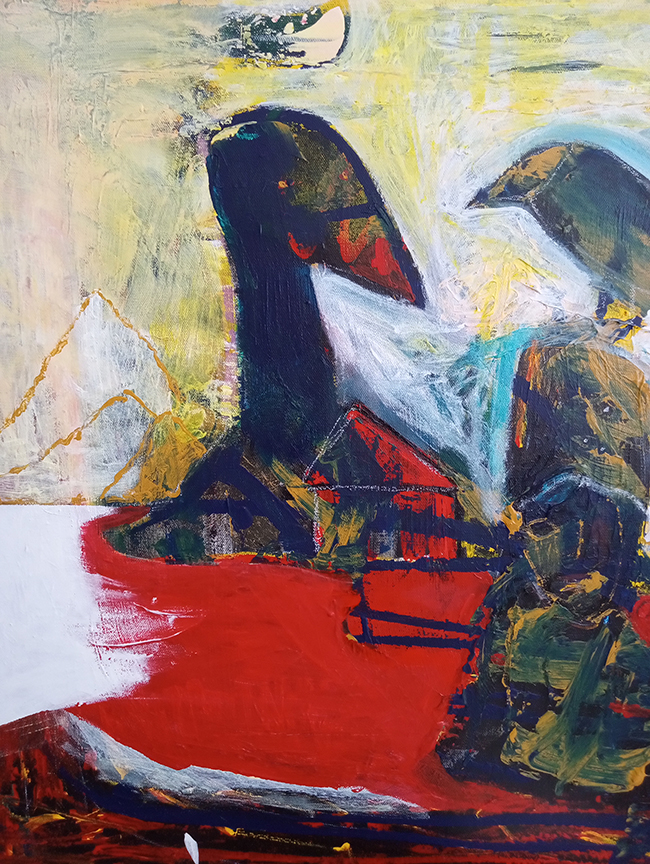Jesse A. Kantu, based in Houston, Texas, commands a distinctive presence in the world of contemporary art. His path is one that combines rigorous training with personal reflection, allowing him to create works that resonate on multiple levels. After graduating from the University of Houston in 2006 with a Bachelor of Fine Arts in Sculpture and a minor in Art History, Kantu expanded his practice by pursuing a Master of Fine Arts in Painting from Houston Baptist University in 2015. These academic experiences, combined with years of exploration, helped him develop an artistic language centered on the complexities of human experience. Kantu engages with themes that bridge the universal and the specific, often examining how people live, feel, and struggle across different cultures. His art is not merely visual—it’s a vessel for empathy, self-examination, and truth, carrying questions about what it means to exist in this world today.

What Can Sympathy Do for Me?
Jesse Kantu’s 2025 painting, What Can Sympathy Do for Me?, stands as a powerful meditation on the limits of compassion and the loneliness that so often shapes the human condition. Measuring 24 by 24 inches and created with acrylics on canvas, the work confronts the viewer with a question that is as intimate as it is universal: what is the true value of sympathy when the act of caring remains passive, when no real healing follows?
Kantu begins with an image that is deeply personal but resonates widely. The voice within the painting speaks: “No one seems to care what I am going through as if I’m invisible.” This sense of invisibility threads through the piece, both in the stark imagery and in the emotional weight it carries. Sympathy, often considered a kind gesture, here becomes hollow—an acknowledgment that does not move beyond recognition. For the artist, sympathy alone is not a balm but a reminder of detachment, a reminder that others may glance at suffering as though looking at “dead flowers.”
The metaphor of dead flowers is a striking choice. Flowers, typically associated with life, beauty, and growth, are here presented as discarded remnants, once vibrant but now neglected. This image cuts to the core of Kantu’s critique: people may notice pain in passing, but too often they fail to nurture or engage with it. The painting, then, becomes not only a personal lament but also a social commentary on how communities and individuals fail to hold space for real healing.
In terms of visual composition, What Can Sympathy Do for Me? makes use of acrylics in a way that heightens this tension. Acrylics allow for both sharp definition and subtle layering, and Kantu employs these qualities to create contrasts between bold, assertive strokes and areas of fragility. These painterly decisions reflect the paradox of sympathy itself: visible on the surface, yet shallow without deeper engagement.
At its heart, the work suggests that sympathy, without action, becomes a reminder of isolation rather than an antidote to it. Healing, Kantu implies, requires more than acknowledgment. It requires presence, patience, and sometimes intervention. In this way, the painting challenges viewers not to remain spectators of another’s suffering but to consider what it would mean to step closer, to transform sympathy into solidarity.
The painting also raises questions about the boundaries between art and life. Kantu places his own vulnerability at the center of the canvas, but he does so in a way that opens the door for viewers to consider their own experiences. Who among us has not felt unseen? Who has not received sympathy without support, recognition without relief? By giving shape to these emotions, the work becomes a mirror, inviting personal reflection and, perhaps, change.
Moreover, What Can Sympathy Do for Me? fits within Kantu’s larger artistic trajectory of probing the human condition. His background in both sculpture and painting gives him a layered approach to form and concept, and here, those skills converge to create a piece that balances intimacy with universality. The painting may be born from a personal struggle, but its message stretches across cultural and social lines, touching on something all too common in human life.
In the end, the work is less about despair and more about truth-telling. Sympathy, though kind in gesture, cannot substitute for deeper forms of connection. Kantu leaves us with a challenge: to see beyond the surface, to resist the temptation of detached observation, and to imagine what true care might look like.
Through this painting, Jesse Kantu doesn’t only express his own reality—he extends an invitation. He asks us to look again at the ways we treat each other, to question whether we are content with offering sympathy or whether we are willing to go further. In that tension lies the power of his work: an honest, unflinching demand that art not only reflect life but push us toward something better.

